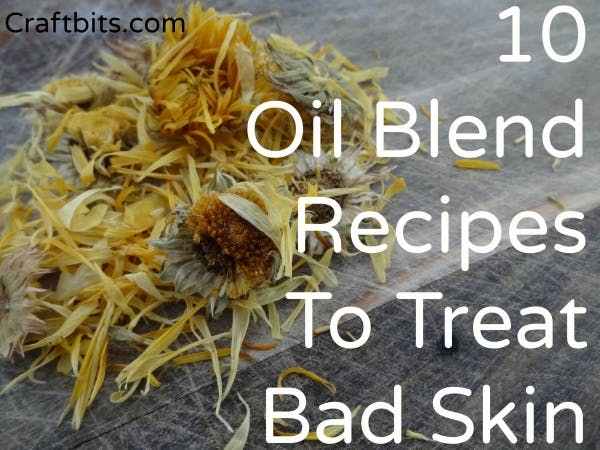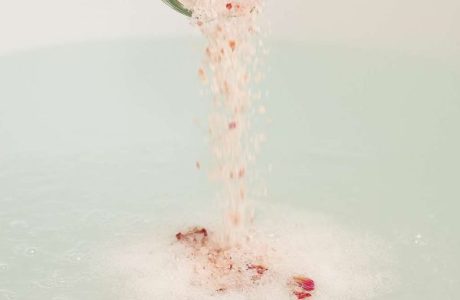
Today we’re talking about 10 oil blend recipes that can help with bad skin. Facial oils are pretty cool because not only can they make your skin look better, but they can also help fix specific issues you might be dealing with. By mixing together cold pressed vegetable oils and essential oils, you can get your skin looking and feeling amazing in no time.
These treatment oils are best used occasionally until your skin starts to clear up. Just apply them at night after you’ve cleansed and toned your skin. If your skin is super dry, you can add a little moisturizer on top of the oil too.
Now, it’s important to keep in mind that you might not see results right away. It can take anywhere from 1-2 weeks for your skin to start improving, so don’t get discouraged if you don’t see a difference right away. Just keep at it and you’ll be amazed at how much better your skin can look and feel!
For facial oils use a 1 percent dilution (20 drops in 5 tbs of base oil) of essential oils. Use only 0.25 percent dilution (5 drops in 5 tbsp of base oil) if using it long term, to prevent the skin from becoming over-sensitised to a particular oil.
Pour the oils into a bottle and shake until well blended.
Recipes and treatments for different types of skins:
Oily Skin – Oily skin is caused by an overproduction of sebum – the natural oil produced by your skin to keep it moisturized and healthy. This overproduction can be due to a variety of factors, including genetics, hormonal imbalances (such as during puberty or pregnancy), certain medications, and even stress. Additionally, using skincare products that are too heavy or not formulated for your skin type can also contribute to oily skin. While having oily skin can be frustrating, the good news is that there are plenty of products and lifestyle changes you can make to help manage it and keep your skin looking and feeling its best!
5 tsp hazelnut oil, 5 tsp jojoba oil
, 4 drops of sandalwood essential oil
s, 3 Mandarin oils, 3 drops of palmarosa
.
Dry skin – Dry skin can be caused by a number of factors. One of the most common causes is simply genetics – some people are just more prone to dry skin than others. Other causes can include environmental factors like cold weather or low humidity levels, using harsh soaps or skincare products that strip the skin of its natural oils, hot showers or baths, and even certain medical conditions like eczema or psoriasis. Additionally, some medications and medical treatments like chemotherapy can cause dry skin as a side effect. So if you’re dealing with dry skin, there could be a number of reasons why – but luckily there are also plenty of things you can do to help alleviate the issue!
1 tbs sweet almond oil, 2 tsp avocado oil, 2 tsp olive oil, 2 tsp of wheat germ oil
, 4 drops of sandalwood oil, 3 of geranium oil, and 3 drops of rose oil.
Combination skin
Combination skin is characterized by having both oily and dry areas on the face. It can be caused by a combination of factors, including genetics, hormonal changes, and using skincare products that are not formulated for your skin type. In many cases, combination skin is simply a result of having a T-zone – the forehead, nose, and chin – that produces more oil than the rest of the face, while the cheeks and other areas may be drier. Changes in weather or seasonal changes can also contribute to combination skin.
Additionally, some people may develop combination skin as they age, as their skin’s natural oil production begins to change. It can be challenging to find the right skincare routine for combination skin, but by using products that are gentle and formulated for your skin type, you can help balance out the different areas of your face and keep your skin looking and feeling its best.
5 tsp jojoba oil, 5 tsp sweet almond oil, 10 drops lavender essential oil, 6 geranium and 4 drops of neroli oil.
Sensitive, eczema or dermatitis skin:
Sensitive, eczema or dermatitis skin can be caused by a variety of factors, including genetics, environmental triggers, and lifestyle choices. People with sensitive skin tend to have a weakened skin barrier, which means their skin is more prone to irritation and inflammation. This can be caused by using harsh skincare products or over-exfoliating, as well as exposure to environmental factors like pollution, extreme temperatures, or UV radiation.
Eczema and dermatitis, on the other hand, are types of inflammatory skin conditions that can cause redness, itching, and flakiness. They are often caused by a combination of genetic and environmental factors, including allergens, irritants, stress, and changes in temperature or humidity.
In some cases, people with sensitive, eczema or dermatitis skin may also have underlying health conditions that contribute to their symptoms. If you’re dealing with any of these skin issues, it’s important to work with a dermatologist or healthcare provider to identify the root cause and develop an effective treatment plan. This may involve avoiding certain triggers, using medicated creams or ointments, or making lifestyle changes to support overall skin health.
5 tsp apricot kernel oil, 5 tsp jojoba oil, 3 drops of chamomile essential oil, 3 atlas cedar wood oil
, 2 lavender, 2 drops of patchouli oil.
Dry skin: Dry skin can be caused by a number of factors. One of the most common causes is simply genetics – some people are just more prone to dry skin than others. Other causes can include environmental factors like cold weather or low humidity levels, using harsh soaps or skincare products that strip the skin of its natural oils, hot showers or baths, and even certain medical conditions like eczema or psoriasis. Additionally, some medications and medical treatments like chemotherapy can cause dry skin as a side effect. So if you’re dealing with dry skin, there could be a number of reasons why – but luckily there are also plenty of things you can do to help alleviate the issue!
1 1/2 tbs apricot kernel oil, 1 tbs jojoba oil, 5 drops rose essential oil, 3 sandalwood oil and 2 drops of palmarosa oil.
Mature skin:
1 tbs jojoba oil, 2 tsp carrot infused oil, 2 tsp evening primrose oil, 2 tsp of rosehip oil,6 drops of rose essential oil, 3 frankincense oil and 2 drops of patchouli oils.
Acne skin:
2 tbs of apricot kernel oil, 1 tbs jojoba oil,2 tsp borage seed oil, 4 drops of carrot seed essential oil
, 2 drops of chamomile oil, 2 drops lavender, 2 drops tea trees essential oils.
Acne scars:
1.5 tbs jojoba oil, 2 tsp rosehip oil, 2 tsps wheat germ oil, 6 drops of sandalwood oil, 4 lavender and 4 drops of neroli oil.
Broken Capillaries:
Broken capillaries are tiny blood vessels that appear as red or purple spider-web like lines on the skin. They are commonly found on the face and legs, and can be caused by a variety of factors.
One of the most common causes of broken capillaries is sun damage, which weakens the walls of the blood vessels and can lead to them rupturing. Other factors that can contribute to broken capillaries include aging, genetics, alcohol consumption, smoking, and certain medical conditions such as rosacea or high blood pressure.
In some cases, broken capillaries can be a result of physical trauma to the skin, such as from a rough facial massage or harsh exfoliation. They can also be a side effect of certain medications, like corticosteroids or blood thinners.
While broken capillaries are typically harmless, they can be unsightly and cause self-consciousness. Treatment options include laser therapy, sclerotherapy, or topical creams containing Vitamin K. It’s important to work with a dermatologist or healthcare provider to determine the underlying cause of your broken capillaries and develop an appropriate treatment plan.
5 tsp of apricot kernel oil, 5 tsp jojoba oil, 4 drops of rose essential oil, 3 chamomile oil, 3 drops of cypress oil.
Pigmentation:
Pigmentation, also known as hyperpigmentation, is a common skin condition that occurs when certain areas of the skin become darker than surrounding skin. This can be caused by a variety of factors, including:
Sun exposure: The most common cause of pigmentation is exposure to UV radiation from the sun. This can lead to the development of sun spots, also known as age spots, on the face, hands, and other areas of the body that are regularly exposed to the sun.
Hormonal changes: Hormonal changes, particularly during pregnancy or menopause, can also cause pigmentation issues. This is because the hormonal changes can trigger an increase in melanin production, which can lead to dark patches on the skin.
Post-inflammatory hyperpigmentation: This type of pigmentation is caused by injury or inflammation to the skin, such as from acne or eczema. As the skin heals, excess melanin production can lead to dark spots or patches.
Genetics: In some cases, pigmentation may be related to genetics. Certain individuals may be more prone to developing pigmentation issues due to inherited factors.
There are a variety of treatments available to help reduce the appearance of pigmentation, including topical creams, chemical peels, microdermabrasion, and laser therapy. It’s important to work with a dermatologist or healthcare provider to determine the underlying cause of your pigmentation and develop an appropriate treatment plan.
1 1.3 tbs of calendula infused oils, 1 tbs rosehip oil, 5 drops of celery essential oil, 5 drops of lavender and 5 drops of lavage oil.






Leave a Reply